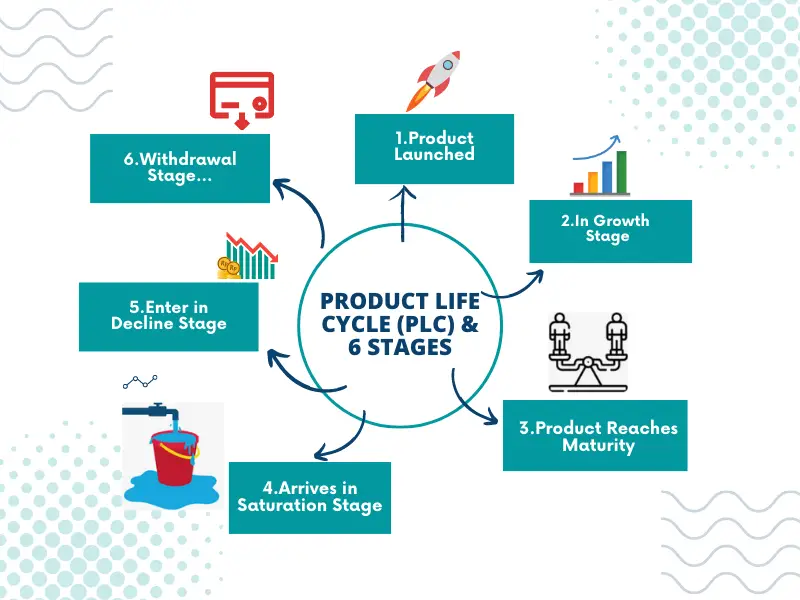The product life cycle (PLC) is a model that describes how a product passes through different stages from its inception to the end of life. The PLC is typically divided into six stages: introduction, growth, maturity, saturation, decline, and rejuvenation or withdrawal. This post explains each of them in detail with examples.
On the other hand, Agile software development is a methodology that can supplement the PLC quite well. It emphasizes iterative and incremental development, customer collaboration, and continuous improvement. Agile teams work in short cycles, called sprints, to deliver working software to customers frequently.
The PLC and Agile software development are complementary approaches that can be used together. Agile allows businesses to shorten the product development cycle and get products to market faster. While the PLC provides businesses with a framework for understanding the stages of the product life cycle and making informed decisions.
What is Product Development Life Cycle?
The product life cycle (PLC) is a concept that describes the stages a product goes through from its introduction to the market to its eventual withdrawal. It is a useful tool for businesses to understand the different stages that a product goes through over its lifetime.
The PLC is typically divided into six stages: introduction, growth, maturity, saturation, decline, and withdrawal. However, the length of each stage can vary depending on the product, the target market, and the competitive landscape.
By understanding the PLC, businesses can make better decisions about pricing, marketing, and product development. For example, businesses may choose to price their products lower in the introduction stage to gain market share, or they may choose to invest more in marketing and promotion in the growth stage to drive sales.
The PLC is a dynamic concept and the product life cycle stages can overlap. Businesses need to be agile and adaptable in order to navigate the PLC successfully.
Product Life Cycle Stages and How Agile Can Help

Introduction Stage
It is the very first step of the product life cycle., At this stage, a product is introduced to the market where sales are typically low. Agile can help businesses in this stage by allowing them to quickly iterate on their development and get feedback from customers. This feedback can be used to improve the product and make it more appealing to customers.
Growth Stage
In the growth stage, sales of a product start to increase rapidly. Agile can help businesses in this stage by allowing them to scale their development team and infrastructure to meet the growing demand for their product. It can also help improve their marketing and sales efforts to reach more customers.
Maturity Stage
In the maturity stage, sales of a product plateau. Agile can help businesses in this stage by helping them to innovate and differentiate their product from the competition. It can also help businesses to improve their customer support and retention efforts.
Saturation Stage
In the saturation stage, the market for a product is saturated and there is little room for growth. Agile can help businesses in this stage by helping them to exit the market gracefully. It can also help businesses to repurpose their product for a new market or application.
Decline Stage
In the decline stage, sales of a product start to decline. Agile can help businesses in this stage by helping them extend their product’s life. It can also help businesses to extract value from their product by licensing it to other companies or selling it to a competitor.
Rejuvenation or Withdrawal Stage
In the rejuvenation or withdrawal stage, a product may be revived or withdrawn from the market. Agile can help businesses in this stage by helping them to assess the feasibility of reviving their product. It can even open the possibility to withdraw their product from the market with minimum risk.
Similar to Agile, SDLC is a time-tested model for developing and releasing software on time. By understanding both models, you might be able to come up with something innovative like a cocktail theory that combines the best of both worlds.
Agile Software Development: Navigating the Journey
Agile software development can be a valuable tool for businesses that are looking to navigate the product life cycle successfully. Here are some of the benefits of using Agile software development:
- Speed to market: Agile teams can deliver working software to customers more quickly than traditional waterfall teams. This gives businesses a competitive advantage by allowing them to get their products to market faster and capture market share before the competition.
- Customer satisfaction: Agile teams are constantly getting feedback from customers, which allows them to make changes to their products that meet customer needs. This leads to higher customer satisfaction and a better reputation for the business.
- Flexibility: Agile teams can adapt to changing market conditions and customer needs more quickly than traditional waterfall teams. This allows businesses to be more successful in the long run, as the market is constantly changing.
Product Life Cycle Theory: Anticipating the Path
Product life cycle theory is a model that can be used to predict the sales and profits of a product over time. The theory states that all products go through a predictable pattern of sales and profits, from introduction to decline. Businesses can use this theory to make decisions about pricing, marketing, and product development.
Here are some of the benefits of using product life cycle theory:
- Pricing: Businesses can use product life cycle theory to set prices that are appropriate for each stage of the product life cycle. For example, businesses may charge a higher price for a product in the introduction stage, when demand is high and competition is low.
- Marketing: Businesses can use product life cycle theory to target their marketing efforts to the right audience at the right time. For example, businesses may focus on building awareness of a product in the introduction stage, and then focus on driving sales in the growth stage.
- Product development: Businesses can use product life cycle theory to plan their product development roadmap. For example, businesses may focus on adding new features to a product in the growth stage, and then focus on improving the product’s performance in the maturity stage.
Using Agile Software Development and Product Life Cycle Theory
Agile software development and product life cycle theory can be used together to help businesses succeed. Agile can help businesses to navigate the product life cycle more effectively by:
- Getting products to market faster
- Being more responsive to customer feedback
- Making changes to products more easily
- Anticipating the sales and profits of products
Product life cycle theory can help businesses to make better decisions about pricing, marketing, and product development by:
- Setting appropriate prices for products at different stages of the PLC
- Targeting marketing efforts to the right audience at the right time
- Planning product development roadmaps
By using Agile software development and product life cycle theory together, businesses can increase their chances of success in the ever-changing marketplace. A leader must be aware of such models.
If you are planing to be a leader, make sure you can answer these interview questions on leadership. These will help you gain insights into your leadership abilities, and refine your responses.
Product Life Cycle Examples
Here are a few simple and relatable product life cycle examples for your reference.
Minecraft

Minecraft is a video game that has had a very unique product life cycle. It was launched in 2009 and was initially a niche product.
However, it quickly gained popularity and became a global phenomenon. Minecraft is currently in the maturity stage of its product life cycle, but it shows no signs of slowing down.
The Hula Hoop
The Hula Hoop is a classic example of a product that has experienced a resurgence in popularity. It was first introduced in the 1950s and quickly became a worldwide phenomenon.
However, the Hula Hoop’s popularity declined in the 1960s and it was largely forgotten about. In recent years, the Hula Hoop has made a comeback and is now enjoying a new lease of life.

Microsoft Windows

Microsoft Windows is a great example of a software product that has gone through all stages of the product life cycle. Windows was first introduced in 1985 and quickly gained market share. In the growth stage, Windows became the dominant operating system for personal computers. Windows reached maturity in the early 2000s, but Microsoft has continued to innovate and release new versions of Windows, which has helped to extend the product’s life cycle.
Google Chrome
Google Chrome is a relatively new software product. But it has quickly gone through the product life cycle. Chrome was first introduced in 2008.
It quickly became the most popular web browser in the world. Chrome is currently in the growth stage and is showing no signs of slowing down.

Conclusion
We hope you learned about the product life cycle and were able to relate its application with examples. The product life cycle and Agile software development are two important concepts for businesses to understand. By understanding these concepts, businesses can make better decisions about product development, pricing, marketing, and growth. By using PLC and Agile software development together, businesses can increase their chances of success.








